2.
GHANA
GCNet sensitisation for timber exporters
The Timber Industry Development Division (TIDD) of the
Ghana Forestry Commission has organised a series of
seminars for timber exporters and major stakeholders in
the industry in order to explain the use of the so-called
eMDA in the processing and approval of timber export
permits. (eMDA is the acronym for the new online
information network between Ministries, Departments and
Agencies)
The exporters were shown the means for electronic
processing of Timber Export Permits, using the Ghana
Community Network Services Ltd (GCNet) platform. This
initiative is expected to address the perceived
communication gap between the TIDD and the industry on
the issuance of permits.
In an address at a workshop in Tema, the Executive
Director of TIDD, Mr. Alhassan Attah said the seminar
formed part of the division’s’ repositioning strategy of
bringing the processing of timber exports to the doorsteps
of exporters.
He added tha, the use of GCNet in timber operations
would also help reduce the cost of doing business, enhance
competitiveness and provide the domestic timber industry
the comparative advantage in the trading of wood
products.
New system an element of VPA
The Executive Director said, GCNet would be benefit the
Forestry Commission in effectively monitoring the
country’s export trade, enhancing data retrieval and serve
as a reliable database for planning, reporting and decision
making. The system would also enable the Commission to
maximise the export revenue collected by the state and
reduce irregularities in the timber trade.
According to Mr. Attah, the use of the GCNet would also
allow for a closer exchange of information among report
related agencies such as the Customs and Exercise and
Preventive Service (CEPS) and other revenue-collecting
agencies for the state.
He said the electronic issuance of export permits was in
line with the terms and conditions of the Voluntary
Partnership Agreement signed between Ghana and the EU
in Sep.2009, where one of the elements was the issuance
of Forest Law Enforcement Governance and Trade
(FLEGT) licence electronically.
The eMDA portal is designed for the electronic processing
of documents and the system enables online submission,
approval and distribution of permits and licenses.
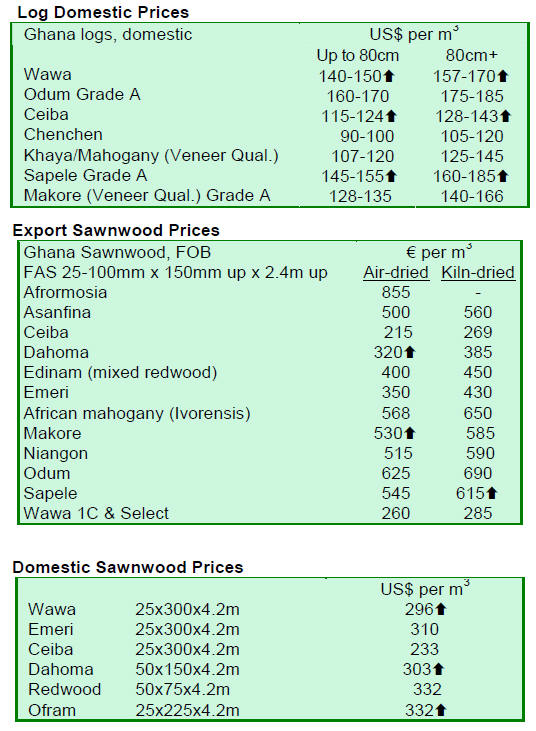
3.
MALAYSIA
Strengthening ringgit hist furniture exports
With the Malaysian ringgit strengthening against most
major currencies, including the US dollar, the Euro and
Sterling, a decline in furniture exports in the current year
is being forecast.
Exports of Malaysian furniture are expected to decline by
up to 15%, from RM7.95 billion in 2010 to RM6.8 billion
for 2011. This decline would be the worst in the past 3
years.
The Malaysia Furniture Entrepreneur Association (MFEA)
reported that exports by its members had declined from
RM1.97 billion in the first quarter 2010 to RM1.66 billion
in the first quarter of 2011. Exports for the second quarter
are expected to come in below RM1.98 billion.
For the Japanese furniture market, exports registered a
12% decline to RM166 million for the first quarter 2011
compared to RM186 million for the first quarter 2010.
Japan was the second largest market for MFEA members
in 2010, with exports valued at RM709 million out of a
total of RM7.95 billion for the year.
Global WoodMart - one-stop centre for buyers and suppliers
The Malaysian Timber Council (MTC) expects that its
Global WoodMart (MGW) 2012 exhibition will showcase
timber and timber products from both tropical and
temperate countries. MTC added that MGW 2012 will act
as a one-stop centre for both buyers and suppliers of
timber and timber products.
Official partner organizations of MGW 2012 are the
American Hardwood Export Council (AHEC) and
FrenchTimber. AHEC has been active in the Asian
markets for many years but FrenchTimber is a relative
newcomer.
FrenchTimber was formed in 2001 at the initiative of the
“Fédération Nationale du Bois” and a group of French
sawmills and it pursues two main goals :
• To promote, on a national as well as international
basis, the use of the different sawn timber species
and processed wood products, coming from
sustainably managed French forests.
• To ease supplies of sawn timber to foreign
companies by increasing the visibility of the
French sawmills’ offer and expertise.
Low river water makes rafting difficult
Prices of Malaysian timber and timber products began to
stabilise in Peninsular Malaysia as dry weather conditions
returned, allowing uninterrupted harvesting and
transportation. However, for Sarawak, the problem of low
water levels in rivers continues to hamper rafting of logs.
No slowing in demand from China and India
The spill-over effects of the EU debt problems and the
weak economy in the US weigh heavily on the timber
export market. This, coupled with the strong Malaysian
ringgit, means that market prospects are gloomy and
analysts report that buyers are maintaining a wait and see
outlook.
However, China and India remain two of the most
important markets for Malaysian timber exporters and
there has been no slowing in the demand in these countries
for raw materials and semi-finished timber products.


4.
INDONESIA
ASEAN cooperation aim at increasing rattan
exports
Indonesia will be the main production centre for rattan
furniture and rattan products among ASEAN countries.
This decision was made by the ASEAN Furniture
Industries Council (AFIC) after taking into consideration
that ASEAN countries were major producers of rattan,
with Indonesia being the largest producer.
According to the director of forest industry and
plantations
at the Indonesian Industry Ministry, the furniture
industries within each ASEAN country will undertake
creation of their own designs and implement marketing
programmes, however, production will take place in
Indonesia as it is only here that raw material is available.
To achieve this manufacturers in the Philippines were the
first to say they would welcome the opportunity to invest
in new factories in Indonesia.
The Indonesian Furniture Industries and Handicraft
Association added that additional market promotion in
countries outside ASEAN member countries will be
organized jointly.
Indonesia claims to possess a sustainable rattan
production
of up to 140,000 tons per year out of a potential yield of
620,000 tons. This constitutes 75% to 80% of the total
global production.
Indonesia’s exports of rattan products stood at US$133
million in 2010 and the latest cooperation between
ASEAN companies is expected to increase exports by
15% and this would mount a challenge to manufacturers in
China.
Indonesia attracts major construction sector
consulting group
UK-based ARUP, one of the world’s largest consulting
firms for the construction industry, will move into
Indonesia to take advantage of one of the world’s fastest
growing construction markets. The move will make it the
second major UK construction related consulting firm to
do so.
According to ARUP, global construction spending is
estimated to increase by US4 trillion from 2010 to 2020,
of which up to 4% is expected to derive from Indonesia
alone. This constitutes an increase of almost U$200bn,
according to a report by Global Construction Perspectives
and Oxford Economics.
The other countries expected to contribute
significantly to
global construction spending within the next decade will
be China, India and the USA.
Indonesia is set to be one of the seven countries that
will
contribute to two-thirds of growth in global construction
projects.
See:
http://www.building.co.uk/news/arup-to-move-into-indonesia-as-marketgrows/
5018287.article
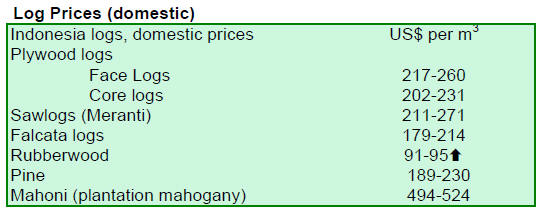

5.
MYANMAR
Demand shifts from Pyinkado to Gurjan
Analysts report that the market for Pyinkado is quiet while
it remains active for Gurjan. Over the past months there
has been a significant shift in demand from Pyinkado to
Gurjan.
Concern over availability of high grade teak logs
The impression of traders is that the availability of high
grade logs is falling. High grades such as Sawing Grades I,
II, and IV, are now not readily available and the same can
be said for Veneer Grades like 2nd, 3rd, and 4th quality logs.
Analysts say that teak logs from areas known to produce
high quality teak can be sold quickly, but these areas are
now not producing as much as in the past. Other, not-sopopular,
areas produce a larger volume of logs, but the log
grades are lower (mainly because of the high incidence of
defects in the logs)and these logs are slow movers.
Trade anticipates shift to conservation
Some local observers are saying there is a need to put
more emphasis on conservation and trade analysts seem to
think that this is the direction the Ministry of Forestry is
heading. June is the month for tree planting and the most
newspapers report this important national activity in detail.
Most analysts feel a change to reduced log harvests is
likely some time soon.
Timber used to be the second most important foreign
exchange earner for the country but this has changed as
natural gas, gems, fisheries and agricultural products are
becoming more important.
Under these circumstances, many analysts agree that
Myanmar has the opportunity to seriously consider a
reduction in log harvests and a switch to more local
processing and export of finished or semi-finished
products. They say that this would be more beneficial for
the country in the long run. Revenue from the forestry
sector at this point in time is made up of around eighty per
cent from log exports.

6. INDIA
Teak log prices firm at local
auctions
Auction sales at Government Forest Depots in Gujarat and
Central India are continuing and price trends for teak have
been reported as firm, this also applies to other hardwood
logs. In the recent sales the ratio of teak to other
hardwoods has been 80: 20.
Pre-monsoon stock building drives up prices of
imported teak
Supplies of plantation teak from Ghana and Ivory Coast
have been erratic recently but Central and South American
supplies have been steady and have continued to support
the demand in Mumbai, Kandla and Mangalore.
Forward contract levels are also reportedly good and
supplies will be maintained in the weeks to come. Premonsoon
stock building by sawmillers is keeping prices
firm.
Shipbuilding quality Teak logs
Rs.2200~2300
First quality Teak Saw-logs
Rs.1800~2000
Long length high girth Teak logs Rs.1500~1800
Average sawmill quality logs
15’& up
Rs.1100~1200
12’& up
Rs.900~1000
8’~10’
Rs.800~ 900
Hardwood logs, Haldu and Laurel Rs.350 ~ 500
Current plantation teak prices C & F Indian ports
remain
unchanged.
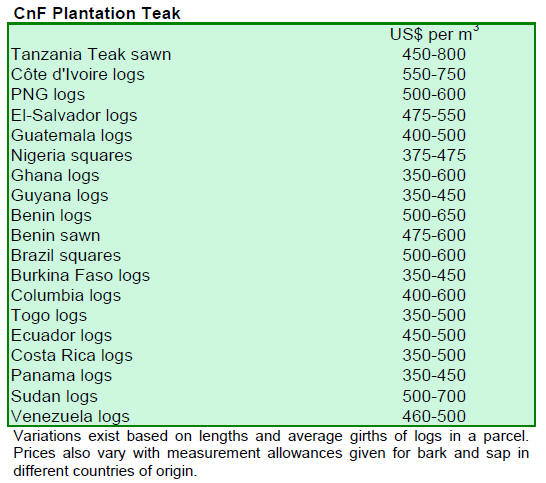
Demand from Europe, USA and Middle East for teak and
other hardwoods remains steady.
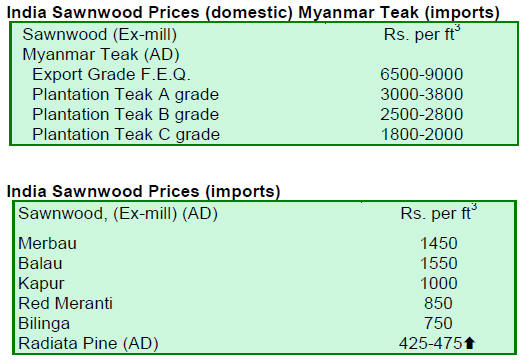
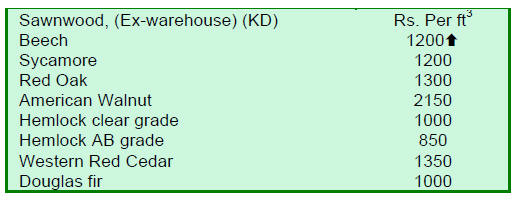
Domestic demand for plywood is firm as construction
activity is in full swing. Raw material prices are not
relenting which has forced local manufacturers to increase
prices once again.
7. BRAZIL
Furniture Federation pleads for tax
relief
The Ceará Federation (FIEC) has pleaded for tax
relief for the furniture and sawmill companies operating in
the state of Ceará.
FIEC has presented a proposal on this on behalf of
two
state unions. The proposal emphasises the importance of
the industrial sector where, in the early part of the year,
sector growth was around 6% above the same period in
2010. However, in recent months this has fallen to around
4.5%.
FIEC claims that the declining growth rate is due
to the
slowdown in the implementation of some government
programmes. For example planned infrastructure
works have not started as scheduled and house building
under the Rural Light Programme is yet to get underway.
However, a growth of 4.5% creates an enormous
incentive
for companies to continue their operations. Entrepreneurs
in the furniture sector are benefiting from the stable
economy and look forward to opportunities stemming
from the World Cup (2014) and the Olympic Games
(2016). These events will likely create opportunities for
many development projects.
FEMADE 2011
The International Fair for the Wood, Furniture and
Forestry Industries is scheduled for late this year and this
will be the 7th fair held.
This is an international event focusing on the development
of the entire production chain – from forestry to furniture
manufacturing. FEMADE 2011 will offer an opportunity
for networking and technology transfer across many
sectors of the forestry and timber industries.
FEMADE 2010 saw a growth of 45% in the number of
exhibitors compared to the previous fair in 2008. Asian,
European and North American companies have invested in
the Brazilian wood and furniture industry and they use
FEMADE to develop business opportunities.
The participation of Deutsche Messe in the
commercialisation of FEMADE 2010 was a decisive
factor for the effective internationalization of the show say
analysts. See
http://www.feirafemade.com.br/
Timber exports double in Alta Floresta, Mato
Grosso
In the first four months of 2011, the municipality of Alta
Floresta has exported a total of just over US$ 10 million,
123% above the same period of 2010 according to the
Ministry of Development, Industry and Foreign Trade
(MDIC).
The main product exported since January, was
tropical
timber, (US$ 5.1 million) followed by meat products (US$
3.8 million). Exports of Ipe sawnwood and veneer sheets
amounted to US$ 536,300.
The United States tops the list of destinations for
exports
(US$ 3.9 million), followed by China/ Hong Kong, (US$
2.6 million), and Iraq (US$ 1.2 million).
Commission approves export processing zones in
Para
The Amazon, National Integration and Regional
Development Commission has approved the Law 7859/10
which authorizes the government to establish an Export
Processing Zone (EPZ) in the municipality of
Parauapebas, in the Northern Brazilian state of Pará.
Companies set up in the EPZs will have tax and
foreign
exchange benefits as well as simplified administrative
procedures for customs.
The state of Para has a large number and
concentration of
tropical timber sawmills and these mills export a high
proportion of their production. It is expected some of these
mills will relocate to the EPZ to secure the benefits
offered.
Few industries utilising plantation teak for
wood products
The state of Mato Grosso is the largest producer of teak in
Brazil, accounting for 90% of the supply in the country.
Many see an opportunity to raise the awareness of
consumers in Brazil and to expand the market for wood
products manufactured from plantation teak.
Currently, young plantation teak in Brazil is used
mainly
as fuelwood by energy-producing companies, grain- and
meat-processing mills, and the ceramic industry, among
others.
The teak plantations in Mato Grosso cover an area
of
around 60,000 ha, with a potential sustainable production
of 900,000 cu.m per year but there are only a few
industries currently utilising this teak for the production of
wood products.
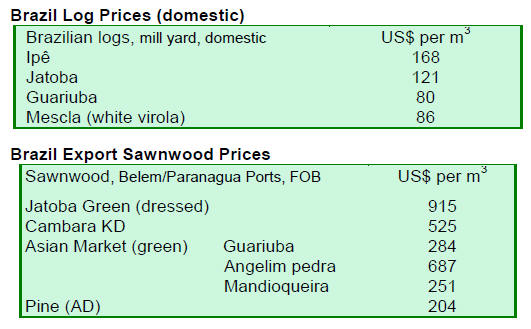
8. PERU
Deadline fast approaching for
enacting forestry law
In the coming weeks, the alternative Forest and Wildlife
Law will be discussed at the plenary session of Congress.
The new draft law contains 147 items that must be
approved before the legislature ends on June 15.
The chairman of the Agricultural Commission has
indicated that his organisation has asked that Congress
make the debate on the new law a priority since the
enactment of this law is essential in order to meet one
element referred to in the various FTAs signed between
Peru and other nations.
The lawmaker added that the new draft is much
improved
and has been strengthened through the input of more than
2,300 community leaders who attended the last national
meeting of native and indigenous communities during the
second half of May.
On the same subject, the chairman of the Timber and
Wood Industry Exporters Association (ADEX) has said
that everything was ready for enactment of the new law
and that it essential that the current session of Congress
enact the law adding that, in his opinion, it would be
irresponsible to defer a decision.
The ADEX representative emphasised that an enacted
Forestry and Wildlife law is one of Peru's outstanding
obligations under the FTA with the United States and if it
is not enacted Peru could face sanctions on its timber
sector.
FSC certification for 75,000 ha. in Madre de
Dios
A spokesperson for one of the largest companies in Peru’s
forestry sector, Wood Bozovich SAC, has obtained a FSC
forest management certification for 75,000 hectares
covering its forest concession "Otorongo" in the Madre de
Dios region.
The company has indicated that the certification
process
was very expensive even for a major Peruvian company
and that other companies as well as some indigenous
communities who had secured certification could not pay
the cost of sustaining the certification.
The company added that unfortunately the market
pays
little or no premium price for certified timber.
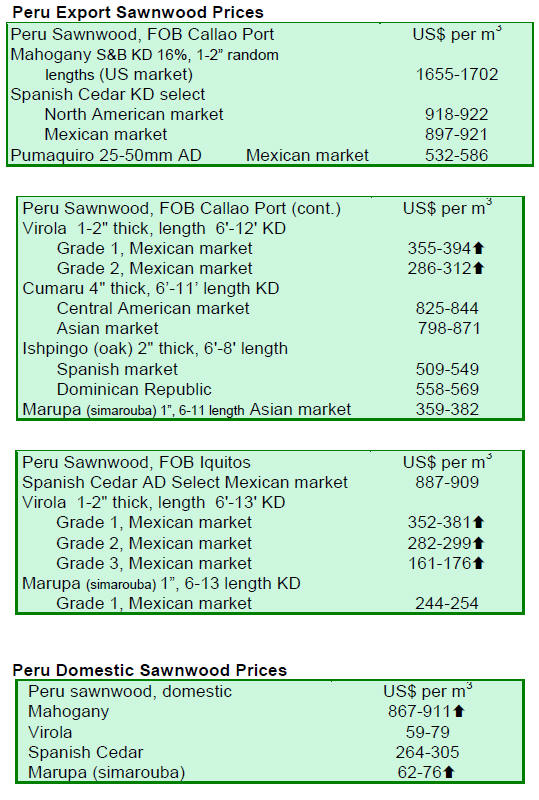
9.
GUYANA
Active demand for Greenheart,
Purpleheart and Mora logs
During the period under review the market for Greenheart
logs was active for both the small and fair sawmill
qualities and good prices were secured.
Purpleheart log prices were also very favourable
for all
qualities, a noticeable improvement from the price levels
last month.
Mora log prices rose for all categories as compared
to the
previous fortnight period.
Guyana’s structural timbers attractive in
overseas markets
Some of Guyana’s structural timbers continue to be of
interest to buyers in Asia, the Caribbean, Europe and
North America. Many of Guyana’s lesser used species are
penetrating the international markets and appear to be used
for structural, outdoor as well as indoor applications.
Locust and Red Cedar in demand
Sawnwood prices for this reported period have been
favourable for both dressed and undressed categories.
Some species, such as dressed Locust, secured
notable
price increases up to US$ 1,018 per cubic metre. Dressed
Red Cedar prices rose to US$1,166 per cubic metre. The
high demand for Guyana’s Washiba (Ipe) continues to
drive up prices which are currently at US$ 2,350 per cubic
metre.
Demand improves for Sawn Greenheart and
Purpleheart
For the period reviewed undressed Greenheart sawnwood
was well received in the market and secured prices of US$
765 to US$ 848 per cubic metre for select grades.
Exporters of un-dressed Purpleheart (select) also enjoyed a
positive rise in the top-end price from US$700 to US$750
per cubic metre.
Dressed Greenheart prices saw an increase in price
from
US$806 to US$890 per cubic metre while dressed
Purpleheart prices also firmed from US$890 to US$975
per cubic metre.
Roundwood and fuelwood exports made a positive
impact
to the overall export earnings. Piles, Poles and Posts all
recorded favorable price increases on the export market in
the Caribbean and North America.
Splitwood exports were consumed entirely by the
Caribbean market and received top-end prices as much as
US$1,135 per cubic metre.
Higher export earnings despite lower log prices
Guyana’s earnings from the forestry sector were mixed
during the first quarter of 2011 compared with the same
period last year, according to the Ministry of Agriculture’s
Commodity Market Update for January to March, 2011.
Against the backdrop of a general decline in
prices, export
earnings from the sector during the first quarter of this
year reached US$9,485,303 compared with
US$11,249,552 during the first quarter of 2010.
During the first quarter of 2011, timber and
plywood sales
accounted for the highest share of export earnings by the
forestry sector, bringing in US$9,189,073 compared to the
US$11,034,741 between January and March 2010.
Earnings from sawnwood exports during the January
to
March 2011 period totalled US$4,566,805 compared to
US$5,059,321 last year, while export earnings from logs
rose to US$4,191,312.50 during the first quarter of 2010.
Overall, export prices for forestry sector trended
down
during the first quarter of 2011 compared with the
corresponding period last year. Export prices for logs fell
by 16% during the January – March period this year
compared with earnings during the same period last year.
Export prices for sandalwood and splitwood also
fell
during the first quarter of this year.
Reduction in export prices but higher export
volumes
Despite the reduction in export prices, increased export
volumes meant that the total export earnings from log
exports from January to March 2011 increased by 9%
compared with the corresponding period last year.
However earnings from the other categories of wood
product exports fell significantly during the first quarter of
this year compared with the same period last year.
Earnings from poles slipped by 70% over the period while
the export value of splitwood dipped by 43% between
January and March this year compared with the same
period last year. Earning from sawnwood also declined
during the first quarter of this year compared to the
corresponding period last year.
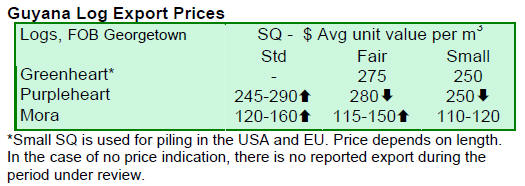
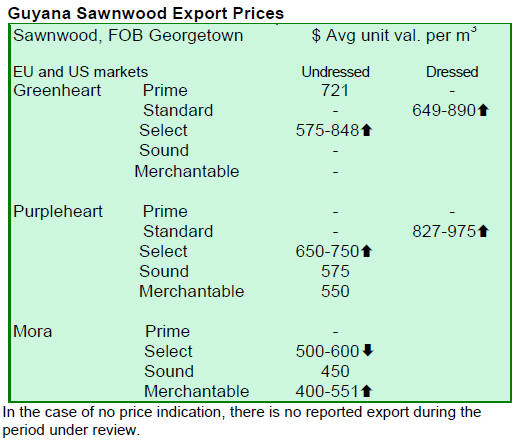
Related News: